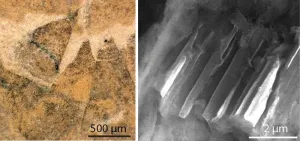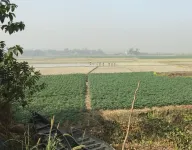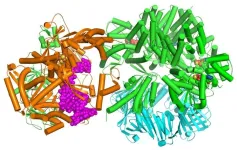(Press-News.org) Seven entrepreneurs comprise the next cohort of Innovation Crossroads, a Department of Energy Lab-Embedded Entrepreneurship Program node based at Oak Ridge National Laboratory. The program provides energy-related startup founders from across the nation with access to ORNL’s unique scientific resources and capabilities, as well as connect them with experts, mentors and networks to accelerate their efforts to take their world-changing ideas to the marketplace.
“Supporting the next generation of entrepreneurs is part of ORNL’s strategy to accelerate transformational energy and manufacturing solutions that are sustainable and resilient, as well as emerging technologies that are vital for the nation’s economy and security,” said Susan Hubbard, ORNL deputy for science and technology.
New this year, the DOE Basic Energy Sciences, or BES, program is joining DOE’s Advanced Materials and Manufacturing Technologies Office, or AMMTO; Building Technologies Office, or BTO; and the Tennessee Valley Authority, or TVA, as a program sponsor.
Innovation Crossroads is a two-year fellowship program focused on energy and advanced manufacturing technologies. Through an annual national call and competitive phased process, top entrepreneurial-minded fellows are selected to join the program. Innovators receive a fellowship that includes a personal living stipend, health insurance, a travel allowance, a substantial grant to use on collaborative research at ORNL and comprehensive mentoring assistance to build a sustainable business model.
Cohort 2024 entrepreneur-fellows also will complete the Spark Cleantech Accelerator, a 12-week program offered by the University of Tennessee, Knoxville, Spark Innovation Center at the UT Research Park.
Cohort 2024 includes:
Katy Bradford, Cassette Construction, is sponsored by AMMTO and BTO. Cassette Construction will produce low-cost, low-carbon wall and floor panels for modular construction using an offsite additive manufacturing process and bio-based materials from rapidly growing plants and waste. This makes the panels carbon-negative and cost-effective. Building construction currently contributes 9% of global carbon emissions, equal to 3 billion tons of CO2 annually. The construction industry also faces a labor shortage, with 41% of the workforce expected to retire by 2031, exacerbating the affordable housing crisis. Cassette Construction reduces on-site labor by up to 89% and minimizes connections by 70%. Their offsite methods enable rapid panel fabrication, potentially increasing industry efficiency and productivity, with an estimated annual profit boost of $265 billion in an $11.5 trillion market. Bradford is currently a BTO IBUILD fellow, researching sustainable construction materials for 3D-printed housing as a doctoral student at the Georgia Institute of Technology.
Jordan Cannon, Circular Biosciences, is sponsored by AMMTO. Poly-L-lactic acid, or PLLA, is a widely used bioplastic, with production expected to increase significantly. However, PLLA's limited biodegradability poses environmental risks, as it is not collected for recycling and often ends up in landfills. Bioplastics, including PLLA, are banned from composting facilities, reducing their environmental benefits. Circular Biosciences offers a solution through enzymatic depolymerization, using engineered protease enzymes that break down PLLA into its component monomers at ambient temperatures. The company aims to develop enzymes that withstand high temperatures and can be integrated into PLLA during extrusion. This additive would enhance PLLA biodegradation in landfills, home composting or natural environments. Cannon is a doctoral student at the University of Tennessee, Knoxville. In his dissertation work, he has focused on the identification, characterization and protein engineering of bacterial enzymes that can depolymerize PLLA.
Vinit Chaudhary, Aligned Composites Technology, or ACT, is sponsored by AMMTO. Aligned Composites Technology produces nonwoven mats for fiber-reinforced composites, achieving precise fiber alignment and blending. The anisotropic — having a different physical value when measured in different directions — mats ensure uniform fiber distribution and incorporate diverse reinforcing fibers, including carbon, glass and natural fibers, as well as thermoplastic polymers. ACT's versatile manufacturing allows for fibers up to 250 millimeters, or mm, far exceeding the 25 mm limit of current techniques. Their nonwovens are lightweight, durable and high-performance, suitable for industries such as automotive, marine, infrastructure, wind, transportation, sporting goods and medical equipment. ACT's cost-effective products can achieve up to 1,500 grams per square meter, or gsm, compared to the 300 gsm limit of existing nonwovens, enabling higher performance with less material. ACT sprouted from Chaudhary’s research work during his master’s program at the University of Tennessee, Knoxville.
Brian Iezzi, Fibarcode, is sponsored by AMMTO. Fibracode tackles the growing textile waste issue in the U.S., where landfill-bound textiles have increased by 80% since 2000. Despite investments in re-use, repair and recycling methods, poor labeling hinders these efforts. Nearly 30% of end-of-use textiles lack readable care labels, and 40% of labels misidentify material content. To improve data transfer from manufacturing to end-of-use, Fibarcode’s photonic fiber barcodes are integrated into fabrics using standard textile processes. The barcodes can be scanned with portable spectroscopic systems, ensuring accurate, durable labeling. Fibarcode can enhance sorting and recycling, potentially capturing $100 billion annually from landfilled apparel, and has applications in anti-counterfeiting, medical garments, military uniforms and supply chain traceability. Iezzi has more than a decade of experience in textile manufacturing and materials research and development including developing novel yarns at the Gaston College Textile Technology Center and at Parkdale Mills, the largest yarn manufacturer in the western hemisphere.
Kevin Roccapriore, AtomQ, is sponsored by AMMTO and BES. Quantum computing leverages quantum mechanics for incredibly fast calculations to solve complex problems. Current quantum computers use different architectures for qubits, such as trapped ions and superconducting circuits. Although existing quantum computers have around 1,000 qubits, practical applications in fields like energy, pharmaceuticals, finance and cryptography require at least 1 million qubits, making scalability a major challenge. AtomQ aims to overcome this by developing a scalable atomic quantum computer using optically active quantum defects created with scanning transmission electron microscopy. Their platform generates precise qubits rapidly, enabling the construction of large qubit arrays in a compact device. Roccapriore was formerly an R&D associate in ORNL’s Data Nanoanalytics group in the Center for Nanophase Materials Sciences, a DOE Office of Science user facility.
Nicholas Sokol, Algaeo, is sponsored by AMMTO. Algaeo makes hardware that allows farmers to grow sustainable, efficient and organic fertilizers on site using micro-algae and artificial intelligence. The company’s technology leverages adsorption to efficiently pull carbon dioxide and nitrogen from the atmosphere to feed algae. Algaeo uses three nontoxic algal strains, which benefit soil health and boost plant growth by providing nutrients, to capture carbon from the atmosphere. Algaeo reduces farmer costs for fertilizer, improves yield and quality, and improves soil health for future growing seasons. Sokol has a background in geography and atmospheric science and has worked across forecasting and field observation and experimentation. He has experience in energy, carbon capture, computational and data science and agricultural sciences.
Tim Vosburgh, Coulomb Technology, is sponsored by AMMTO and TVA. Coulomb Technology is developing and will manufacture novel battery cells for energy storage, backup power and mobility. These batteries are based on zinc, manganese dioxide and sea water, and are safer, utilize abundant materials, are faster charging, and are half the price of the incumbent lithium batteries. Coulomb cells feature a special 3D-electroplated anode. This design helps reduce dendrites — small crystalline structures that can cause battery failure — and corrosion. It is effective even in environments with low pH levels. Vosburgh has nearly thirty years in electronics and contract manufacturing, and a history of entrepreneurship in advanced battery technologies.
UT-Battelle manages ORNL for DOE’s Office of Science, the single largest supporter of basic research in the physical sciences in the United States. The Office of Science is working to address some of the most pressing challenges of our time. For more information, please visit energy.gov/science.
END
Innovation Crossroads welcomes seven entrepreneurs for Cohort 2024
2024-08-01
ELSE PRESS RELEASES FROM THIS DATE:
American College of Rheumatology opens press registration for ACR Convergence 2024
2024-08-01
FOR IMMEDIATE RELEASE
Aug. 1, 2024
Media Contact:
Monica McDonald
(404) 365-2162
mmcdonald@rheumatology.org
American College of Rheumatology Opens Press Registration for ACR Convergence 2024
ATLANTA – Complimentary press registration is now open for journalists to cover research presented at ACR Convergence 2024, taking place Nov. 14-19 at the Walter E. Washington Convention Center in Washington, D.C. A listing of sessions for the meeting can be found in the online program.
Approved ...
Half a billion-year-old spiny slug reveals the origins of mollusks
2024-08-01
UNDER EMBARGO UNTIL 19:00 BST / 14:00 ET THURSDAY 1 AUGUST 2024
Images available via link in the notes section
Exceptional fossils with preserved soft parts reveal that the earliest molluscs were flat, armoured slugs without shells.
The new species, Shishania aculeata was covered with hollow, organic, cone-shaped spines.
The fossils preserve exceptionally rare detailed features which reveal that these spines were produced using a sophisticated secretion system that is shared with annelids (earthworms and relatives).
A team of researchers including scientists from the University of Oxford have made an astonishing discovery of ...
Award-winning research maps the body’s internal sensory communication highway
2024-08-01
When the question is “how are you feeling on the inside?,” it’s our vagus nerve that offers the answer.
But how does the body’s longest cranial nerve, running from brain to large intestine, encodes sensory information from the visceral organs? For his work investigating and mapping this internal information highway, Qiancheng Zhao is the 2024 grand prize winner of the Science & PINS Prize for Neuromodulation.
Interoception—the body’s ability to sense its internal state in a timely and precise manner—facilitated by the vagus plays a key role in respiratory, gastrointestinal, cardiovascular, endocrine and immune ...
Current Andean glacier loss is unprecedented in the Holocene
2024-08-01
Andean tropical glaciers are experiencing unprecedented retreat, according to a new study that reveals their current sizes are the smallest in over 11,700 years. “Our finding … identifies this region as a hot spot in our understanding of the changing state of the cryosphere,” say the authors. Glaciers act as important indicators of climate change, with their global retreat accelerating over recent decades. Examining this retreat in the context of the previous 11,700 years of the Holocene interglacial highlights the impact of modern global warming. Although many glaciers worldwide are smaller today compared to ...
New fossil resembling a bristly durian fruit reveals insights into the origin of molluscan skeletons
2024-08-01
The early evolution of mollusks has been hard to pin down, but now a newly discovered fossil – of a shell-less, soft-bodied, spiny mollusk from the early Cambrian – provides crucial insights, researchers report. The findings suggest that this fossil, of a creature called Shishania aculeata, is a stem mollusk – representative of an intermediate between early members of the superphylum lophotrochozoans and more derived mollusks. Mollusks are one of the most diverse groups of animals, encompassing various well-known forms such as clams, ...
CLEAR: a new approach to 3D printing materials with highly entangled polymer networks
2024-08-01
Researchers have developed a novel approach to three-dimensional (3D) printing they call “CLEAR,” which significantly improves the strength and durability of materials by using a combination of light and dark chemical reactions to create densely entangled polymer chains. The authors used their approach to print structures with special features, such as the ability to adhere to wet tissues. Incorporation of polymer chain entanglements as reinforcements within 3D printed materials can significantly enhance their mechanical properties. However, traditional vat photopolymerization-based 3D printing techniques, such as digital ...
Genetic insights into how prickles develop across different plants, despite evolutionary separation
2024-08-01
The evolutionary gain and loss of plant prickles – sharp pointed epidermal outgrowths – are controlled by a shared genetic program involving cytokinin biosynthesis, researchers report. The study sheds light on the genetic basis of the emergence of similar traits in distantly related organisms and reveals genomic targets for prickle removal for crop improvement. The genetic basis of trait convergence is a central question in evolutionary biology, and the extent to which it is driven by ...
Climate anomalies may play a major role in driving cholera pandemics
2024-08-01
New research suggests that an El Niño event may have aided the establishment and spread of a novel cholera strain during an early 20th-century pandemic, supporting the idea that climate anomalies could create opportunities for the emergence of new cholera strains. Xavier Rodo of Instituto de Salud Global de Barcelona, Spain, and colleagues present these findings in the open-access journal PLOS Neglected Tropical Diseases.
Since 1961, more than 1 million people worldwide have died in an ongoing cholera pandemic, the seventh cholera ...
Study shows link between asymmetric polar ice sheet evolution and global climate
2024-08-01
Recent joint research led by Professor AN Zhisheng from the Institute of Earth Environment of the Chinese Academy of Sciences has revealed the pivotal role of the growth of the Antarctic ice sheet and associated Southern Hemisphere sea ice expansion in triggering the mid-Pleistocene climate transition (MPT). It has also shown how asymmetric polar ice sheet evolution affects global climate.
The MPT refers to a shift in Earth’s climate system between about ~1.25–0.7 million years ago, marking a shift to more pronounced and regular ...
When it comes to DNA replication, humans and baker’s yeast are more alike than different
2024-08-01
GRAND RAPIDS, Mich. (Aug. 1, 2024) — Humans and baker’s yeast have more in common than meets the eye, including an important mechanism that helps ensure DNA is copied correctly, reports a pair of studies published in the journals Science and Proceedings of the National Academy of Sciences.
The findings visualize for the first time a molecular complex — called CTF18-RFC in humans and Ctf18-RFC in yeast — that loads a “clamp” onto DNA to keep parts of the replication machinery from falling off the DNA strand.
It is the latest discovery from longtime collaborators Huilin Li, Ph.D., of Van Andel Institute, ...





